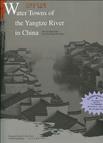江南水乡古镇
出版时间:2009-11 出版社:上海人民美术出版社 作者:阮仪三 著,费玉英 等译 页数:177 译者:费玉英
Tag标签:无
前言
Southern China refers to the southern areas of the Yangztze River in general including southern JiangsuProvince and northern Zhejiang Province and locates in subtropical zone.The Yangtze River and Taihualluvial Plain systems are flourishing.The mild and moist climate nourishes plentiful products.After the5t1I century A.D.,the canal and manual rivers and channels were cut,which helped develop the water traffic,which in turn caused the form of numerous richly-endowed water towns.For thousands of years,everyhousehold was adjacent to water with boats went through it,which forms the unique spectacles and featuresof”small bridge,flowing water and household”。With the prosperous economy,stable life and developedculture,people here always attached great importance to education which helped produce many culturalcelebrities and various literatures and works of art bearing rich cultural customs with local characteristics.Every water town in southern areas of the Yangtze River has its own economic traits,and the neighbouringtowns are separate in their economies.In the past,they possess their own handcraft industries and commodityspecialties.some of which last till now.The water towns are constructed in concert with water.there fore thewater and street lanes are main passages of livelihood and transportation. Houses are intentionally built nearwater with the street in front and the fiver at the back.The water corridor, water house,water pavilion,waterbuilding and small bridge constitute the distinctive living environment where people and nature are stayingharmoniously together.Because of the differences in the geographical environment and social economic function,every ancient town took on different looks and connotations through the long evolution of history,which reveal the rich and profound traditional characteristics of the ancient water towns in southern areas of the Yangtze River,Between the 13th and 19th centuries.the ancient towns flourished for a time and the total number of townsreached hundreds.Since the 1980s,with the rapid development of society and economy in China,most of theancient towns had industrial construction.started land traffic and built modern construction and facilities.Theoriginal network of rivers and traditional settlements is scraped,so the original features of the ancient water towns disappeared gradually.In the mid-1980s,we timely and properly took measures to protect and plan forthe ancient towns near Suzhou such as Zhouzhuang,Tongli,Luzhi and those of Nanxun,Jiaxing,Wuzhen,Xitang in Huzhou.At the beginning of the 90s,Zhujiajiao and Xinchang in Shanghai,Anchang,Longmenand Qiantong in Zhejiang as well as Mudu in Suzhou also received planning and guide.Therefore,theoriginal features of the ancient water towns are kept completely and the tourist industry is properly developed.Luckily,a very precious historical heritage is kept for people.
作者简介
Ruan Yisan'RHF President,Professor Ruan Yisan.Dircctor of National ResearchCenter of Historic City at Tongji University,isemeritus professor of Urban Planning at the College ofArchitecture and Urban Planning,Tongji University.He is also a member of the Urban Planning ExpertCommittee of the Ministry of Construction,theNational Conservation Expert Committee of HistoricCities,and Vice Director of the Academic Committeeof HistorjC Cities.Professor Ruan Yisan has been working as a consultantfor many historic cities such as Suzhou,Yangzhou,Hangzhou,Shaoxing,Pingyao,and Lijiang. Hehas made a major contribution to the education andresearch of urban development history and urbanheritage conservation.He has helped safeguard manyhistoric cities and towns from imprudent developmentand made them important heritage sites throughconservation planning and practice,such as Pingyao,Zhouzhuang,Tongli,Luzhi,Nanxun,Wuzhen,andXitang.Under his supervision,the project of the Yangtze RiverWater Towns(including Zhouzhuang,Tongli,Luzhi,Nanxun,Wuzhen and Xitang)was granted the Awardof Distinction by the UNESCO Asia-Pacific HeritageAwards for Culture Heritage Conservation in 2003.In 2005,Professor Ruan Yisan was awarded a KnightMetal of Art and Literature by the Dench Ministry ofCulture.
书籍目录
PrefaceCommon Traits of Ancient Water TownsSouth of the Yangtze RiverZhouzhuangWuzhenNanxunTongliXitangLuzhiZhujiajiaoXinchangQiantongAnchangMuduLongmenThe Protection and Implementation of Planning for Water Towns South of the Yangtze River
章节摘录
插图:The architecture and layout of the water towns are a perfect combination of the idea ofman-and-heaven unity and the economic factors:the seemingly casual but well-plannedlayouts,simplified shapes,light and friendly colors and soft beautiful lines.To facilitateeconomic exchanges,all houses are built along the rivers or the streets and are SO designedthat they incorporate shopping,residence and production functions.By the patios and thelong windows the inner chambers are connected to the outer halls,Affinity with water isubiquitous——the streets in front,the rivers behind,the waterside houses,the waterwall gates,the bridge ends,the sheltered water verandas,the waterside cabinets,and the water sidepavilions.There are even cases where the water runs through the house,a perfect illustrationthat human beings live harmoniously with the surroundings.Compared with towns of other parts of China,the water towns here are more subject toeconomic influences in the process of their development and water has become the centralelement in the unique local surroundings and life for obvious geographical reasons.Asculmination of wisdom of forefathers of the people living here,the water towns have beenplaying a positive role in the evolution of towns of China in general.Since the 1980s,vast changes have taken place in China.Because of the rapid economicgrowth,changes of social and economic map,expansion of modern industry,construction ofhigh buildings and increasing number of roads,the water grids and the traditional houses aredisappearing. Fortunately there are exceptions,among which are Zhouzhuang,Tongli,Luzhi,Jinxi and Mudu of Suzhou,Nanxun of Huzhou,Wuzhen and Xitang of Jiaxing,as well asZhujiajiao and Xinchang of Shanghai.Only in these places far from the modern roads wherethe local governments marked out new zones for modern construction in the mid 1980s are theancient water towns preserved intact as a historical heritage.
编辑推荐
《江南水乡古镇(英文版)》:随书附赠12张江南水乡古镇精美明信片
图书封面
图书标签Tags
无
评论、评分、阅读与下载
用户评论 (总计0条)
推荐图书
- 深入Windows编程
- 新编网页制作
- 同济大学学生建筑设计作品选2000-2001
- 《初中物理分类训练与分项测试》第二册 (平装)
- 初中地理分类训练与分项测试(第4册) (平装)
- 初中语文分类训练与分项测试..(第二册) (平装)
- 新标准精编教辅丛书
- 初中版.重大时事综合分析复习资料
- 2006重大时事综合分析(初中版.下) (平装)
- 上海市初中数学学科教学基本要求 (平装)
- 初中语文分类训练与分项测试(第4册) (平装)
- 初中生物分类训练与分项测试(第1册)(下) (平装)
- 初中物理2 (平装)
- 初中语文复习(上海版H版) (平装)
- 新编初中数学复习 (平装)
- 初中语文分类训练与分项测试(第1册) (平装)
- 初中代数分类训练与分项测试(第2册) (平装)
- 初中几何分类训练与分项测试(二册.) (平装)
- 初中代数分类训练与分项测试(第3册) (平装)
- 初中地理分类训练与分项测试(3册) (平装)
- 初中语文分类训练与分项测试(第5册) (平装)
- 初中思想政治分类训练与分项测试(第2册)(上) (平装)
- 初中代数分类训练与分项测试(第1册)(上) (平装)
- 初中语文分类训练与分项测试(第3册) (平装)
- 高中语文:3年级(第1学期)(S版) (平装)
